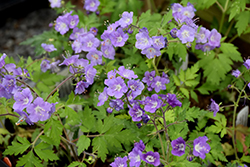It's all about ...
plants

Height: 30 inches
Spacing: 3 feet
Sunlight:
![]()
![]()
Hardiness Zone: 6a
Other Names: Scorpion Weed, Forest Phacelia, Spotted Phacelia
Description:
A biennial native woodland wildflower featuring a loose, open habit and ferny, bright green leaves; a profusion of lavender to deep blue-violet flowers appear in spring to early summer of its second year; readily self sows, keeping its presence
Ornamental Features
Fernleaf Phacelia features showy racemes of purple buttercup flowers with lavender overtones and white eyes at the ends of the stems from early spring to early summer. Its attractive ferny compound leaves remain light green in colour throughout the season.
Landscape Attributes
Fernleaf Phacelia is an open herbaceous biennial with an upright spreading habit of growth. Its relatively fine texture sets it apart from other garden plants with less refined foliage.
This is a relatively low maintenance plant, and should not require much pruning, except when necessary, such as to remove dieback. It is a good choice for attracting bees and butterflies to your yard. Gardeners should be aware of the following characteristic(s) that may warrant special consideration;
- Self-Seeding
Fernleaf Phacelia is recommended for the following landscape applications;
- Mass Planting
- Rock/Alpine Gardens
- General Garden Use
- Groundcover
- Naturalizing And Woodland Gardens
Planting & Growing
Fernleaf Phacelia will grow to be about 24 inches tall at maturity, with a spread of 4 feet. When grown in masses or used as a bedding plant, individual plants should be spaced approximately 3 feet apart. It grows at a fast rate, and tends to be biennial, meaning that it puts on vegetative growth the first year, flowers the second, and then dies. However, this species tends to self-seed and will thereby endure for years in the garden if allowed.
This plant does best in partial shade to shade. It does best in average to evenly moist conditions, but will not tolerate standing water. It is particular about its soil conditions, with a strong preference for rich, acidic soils. It is somewhat tolerant of urban pollution. This species is native to parts of North America..
This plant is not reliably hardy in our region, and certain restrictions may apply; contact the store for more information.
